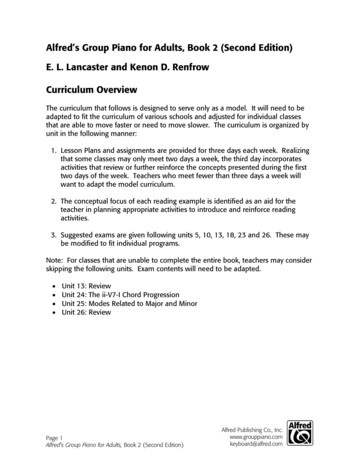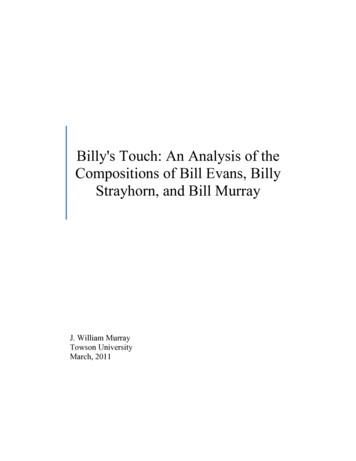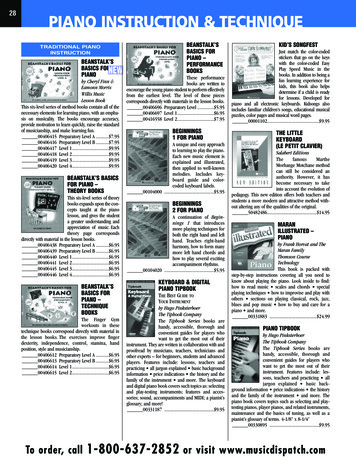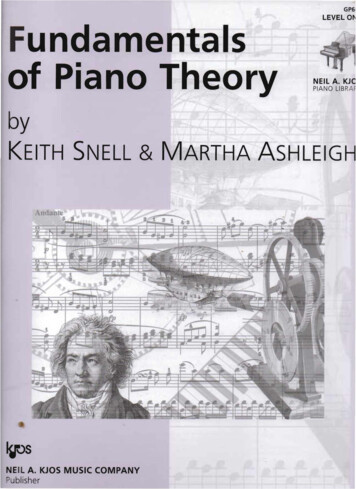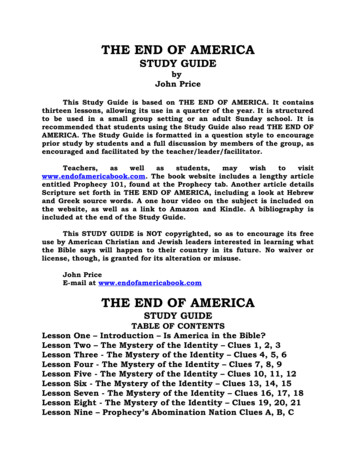
Transcription
Inclu5 books, des13 CD& this ’s,Study GuideYour Next Step: Hundreds of Shortcuts, Tactics, Cheap Tricks,Misdirections, Cover Ups, Trade Secrets, Insider Information,and Ruses for Mastering Piano in 18 Months or LessHome Study CollectionSuccess Manualwith Robert Laughlin
IntroductionFirst Month: Basic Blues TechniquesWelcome to your 18 month piano course. You will be working infive different course books. Each month focuses on one certainbook. All reading assignments and CD Track references refer tothat particular program you will be studying that month. You won’tcomplete any program in a single month, allowing you to skiparound, back and forth, as your skills gradually develop.We’ll start out with the blues, something that’s useful, easy, andfun. The blues can be played on its own, or used to ornament otherstyles of music.Week OneWarm UpRead Continuing Chord Piano section on the Major ChordDrillMajor Chord Drill CD, tracks 1-3This can be played away from the keyboard as a mentaldrill as well. Make good use of commute time or workouttime.Hands OnBlues Piano Styles book, Example 1How to Play Blues & Boogie-Woogie Piano CD, tracks1-4We only list four weekly lessons each month. Often the lessons inWeek Four will be more extensive and/or challenging, keeping inmind that you have slightly more than four weeks in each month.The learning pace established here is just a suggestion. With 30minutes piano practice per day, you can get through these materialsin 18 months. However, if you wish to work faster by putting moretime in, you can. Conversely, you can take this course as slowly asyou wish. The actual skill-based tasks should take at least one yearto learn. Training your hands take time, no matter how fast youactually learn the information mentally. Because every part of whatwe teach is recorded, there’s no chance of forgetting the material.Week TwoWarm UpRead Continuing Chord Piano section on the Minor ChordDrillMinor Chord Drill CD, tracks 1-3This can be played away from the keyboard as a mentaldrill as well. Make good use of commute time or workouttime.Hands OnBlues Piano Styles book, Example 2How to Play Blues & Boogie-Woogie Piano CD, tracks5-8Each week there will be a “Warm Up” segment and a “Hands On”segment. In addition you should be working on learning songs.What songs you learn will be your personal choice, but you mightwant to plan on starting a new song each week, just to buildyour repertoire. By learning new songs you will be able to takethe lessons from each week and make them come alive. Choosemusic you genuinely like. If you get stuck on a song, set it asidetemporarily, and learn something else for the time being.Week ThreeWarm UpHanon - Exercise One (or review Major and Minor ChordDrills)Hands OnBlues Piano Styles book, Example 3How to Play Blues & Boogie-Woogie Piano CD, tracks9-11In addition to sheet music there will be some other things you’llneed to provide for yourself, primarily Hanon. You can purchase“Hanon” (The Virtuoso Pianist in Sixty Exercises by C.L. Hanon)at most music stores at a very reasonable cost. Be sure all threevolumes are included in the version you buy. You will be workingmostly in Volumes 1 and 2.Week FourWarm UpHanon - Exercise Two (or review Major and MinorChord Drills)Hands OnBlues Piano Styles book, Example 4How to Play Blues & Boogie-Woogie Piano CD, tracks12-16Other purchases are optional. Some music paper if you want to write out some of the examplesin music form (try it, it’s fun). A metronome (I recommend an electronic one as opposed to thewind up kind). A notebook for keeping a journal. Each week be sure to writeout your goals, note your progress, and plan your future songrepertoire. Here is where you keep track of your metronomespeeds as well.Are you ready? Let’s get going.
Second Month: Basic Right Hand TechniquesThird Month: Basic Left Hand TechniquesNow we’ll learn ways to make your right hand melodies moreinteresting.Last month you worked on ways to make your right hand moreinteresting. This month we’ll do the same with the left hand.Week OneWarm UpMajor Chord Drill CD, tracks 4-8Hands OnLearn Chords to “Georgia” (Continuing Chord Piano)Simple Right Hand Variations CD, tracks 1-3Week OneWarm UpDrill 3, Major Chord Drill CD, tracks 11-24Make this an ongoing exercise until its thoroughlylearned.These drills can be used with or without a piano.Hands OnContinuing Chord Piano book (Left Hand Variationschapter)Learn Chords to three Sample songsSimple Left Hand Variations CD, track 1Week TwoWarm UpMinor Chord Drill CD, tracks 4-7Hands OnStart song “Georgia on My Mind”(Continuing Chord Piano)Simple Right Hand Variations CD, tracks 4-5Week TwoWarm UpHanon - Exercise FiveHands OnContinuing Chord Piano book (Left Hand Variationschapter)Learn three Sample songsSimple Left Hand Variations CD, track 2Week ThreeWarm UpHanon - Exercise ThreeMajor Chord Drill CD, track 9 (Bonus drill)Hands OnContinue with “Georgia on My Mind”(Continuing Chord Piano)Simple Right Hand Variations CD, tracks 6-8Week ThreeWarm UpDrill 3, Minor Chord Drill CD, tracks 9-21Make this an ongoing exercise until its thoroughlylearned.These drills can be used with or without a piano.Hands OnContinuing Chord Piano book (Left Hand Variationschapter)Learn chord patterns in 4/4Simple Left Hand Variations CD, tracks 3-4Week FourWarm UpHanon - Exercise FourMinor Chord Drill CD, track 8 (Bonus drill)Hands OnContinue with “Georgia on My Mind”(Continuing Chord Piano)Learn first four right hand techniquesSimple Right Hand Variations CD, tracks 9-13Week FourWarm UpHanon - Exercise SixHands OnContinuing Chord Piano book (Left Hand Variationschapter)Learn chord patterns in 3/4Simple Left Hand Variations CD, track 5
Fourth Month: Introduction to Play by EarFifth Month: Blues Piano Styles (continued)We’re going to start learning the major scales this month. Thenwe’ll explore the secrets of playing by ear.Back to more hands-on playing. You should enjoy these boogiesounds.Week OneWarm UpHanon – Exercise SevenHands OnRead Chapter One, How to Play Piano by EarListen to CD: Play by Ear Workshop Program – Part One,CD tracks 1 - 4Week OneWarm UpReview the material you covered in the Major and MinorChord Drill CD’s.Hands OnExample Six in the book. Tracks 17-18 on How to PlayBlues and Boogie Woogie CD. This is challenging. Makesure you learn it from memory, not the music in the book.Week TwoWarm UpStart C major scale in Vol. 2 Hanon 39, or any scale book,Right Hand onlyHands OnListen to CD: Play by Ear Workshop Program – Part One,CD tracks 5 – 6Learn the first song on Song List One, page 7, “Down inthe Valley”Use the practice CD that comes with the book, CD tracks1-6Week TwoWarm UpF major scale, using the study sequence outlined lastmonthExtra: Start using a metronome with your scales. Set it asslow as you need in order to play scales perfectly. Perhapstry the two hands separately at first.Hands OnExample Seven: Preliminary Boogie Woogie Pattern. CDtracks 19 – 20.Example Eight: Right Hand Boogie Chords. CD tracks 21– 22.Week ThreeWarm UpContinue C major scale, Vol. 2 Hanon, or any scale book,Left Hand onlyHands OnContinue learning the next two songs on Song List Oneby ear.Use the practice CD that comes with the book, CD tracks7 - 11Week ThreeWarm UpHanon – Exercise EightContinue perfecting the F major scale. Increasemetronome speed, if ready.Hands OnBlues Example Nine: Putting the Two Hands Together.CD Tracks 23 – 24.Week FourWarm UpC major scale, BOTH hands, up and down, four octaves,correct fingeringExtra: Review Hanon Exercises 1 - 7Hands OnContinue learning the last two songs on Song List One byear.Use the practice CD that comes with the book, CD tracks12 - 15ExtraAny extra time you have this month, work on yourrepertoire. Are you keeping up with your goals?Week FourWarm UpStart the G major scale in the same way you’ve learnedthe other two.Hands OnBlues Example Ten: True Eight-to-the-Bar Pattern. CDtracks 25 – 26.ExtraReview songs you’re learned. Start a new one.You should have at least eight songs in your repertoire bynow.
Sixth Month: Play by Ear (continued):Three Chord SongsSeventh Month: Finish Continuing Chord PianoAfter this month you should know how to play at least 100combinations of right and left hand accompaniment variations.Playing by Ear gets a little more challenging this month.Week OneWarm UpHanon Exercise Nine with metronome.Start on E flat major scale.Hands OnRight Hand Variations numbers 6 – 9, pages 19 – 20.Right Hand Variations CD tracks 15 – 18.Week OneWarm UpReview Hanon 1 – 4. Try to get the metronome between90 – 100.Hands OnRead Chapter Two of Play by Ear book.Listen to CD: Play by Ear Workshop Program – Part One,CD tracks 7 - 9Learn “Saints Go Marching In” (Song List Two) by ear.Refer to practice CD (15 songs) that comes with the book,CD tracks 16 - 18Week TwoWarm UpHanon Exercise Ten with metronomeContinue perfecting the E flat scale.Hands OnLeft Hand Variations: Arpeggio techniques. ContinuingChord Piano book, page 28 CD tracks 6 - 16Week TwoWarm UpLearn the B flat major scale as before.Hands OnLearn next two songs, Song List Two.Refer to practice CD (15 songs) that comes with the book,CD tracks 19 - 22Week ThreeWarm UpHanon Exercise Eleven with metronome.Start the A major scale.Hands OnLeft Hand Variations: Bass and chord techniques.Continuing Chord Piano book, page 29 CD tracks 17 - 24Week ThreeWarm UpReview Hanon 5 – 8. Try to get the metronome between90 – 100.Hands OnLearn final two songs, Song List Two.Refer to practice CD (15 songs) that comes with the book,CD tracks 23 - 26Week FourWarm UpPerfect the A major scaleReview E flat major scaleStart increasing metronome speedReview Hanon 9 - 11Hands OnReview all Right Hand TechniquesStart combining Left Hand and Right Hand techniques,using all the songs in the Continuing Chord Piano book.Then branch out to songs in your own list.Pay particular attention to “Georgia on My Mind.”ExtraYou will find more of these left and right hand techniquesin our program “The Season” (not part of this package).Week FourWarm UpLearn the D major scale as before.Hands OnTry a few of the Two Chord and Three Chord Songs listedon page 15, Piano by Ear book.
Eighth Month: Piano by Ear – Song List ThreeNinth Month: Finish Blues and Boogie-WoogieNow we’re really starting to challenge you with more difficultsongs to play by ear. How well do you know your basic chords bynow?This wraps up the basic blues and boogie course. You will continueto work with your improvising.Week OneWarm UpD flat major scaleStart Hanon Exercise 13Hands OnExample 11: Another Left Hand Boogie PatternCD tracks 27 – 28Example 12: A Third Left Hand Boogie PatternCD tracks 29 - 30Week OneWarm UpHanon Exercise Twelve with metronome.Hands OnRead Chapter Three of How to Play Piano by Ear.Listen to CD: Play by Ear Workshop Program – Part Two,CD tracks 1 - 2Memorize any of the chords from the Top Twelve List ofChords that you do not already know.Week TwoWarm UpB major scaleHands OnExample 12: A Third Left Hand Boogie PatternCD tracks 29 - 30Week TwoWarm UpA flat major scaleHands OnLearn the first song on Song List Three, page 16, “JingleBells”Use the practice CD that comes with the book, CD tracks27 - 29Week ThreeWarm UpHanon Exercise 14Hands OnExamples 13 and 14: Blues/Boogie Right Hand PatternCD tracks 31 - 36Week ThreeWarm UpE major scaleHands OnLearn next two songs, Song List Three(“ Michael Row” and “Aura Lee”) .Refer to practice CD (15 songs) that comes with the book,CD tracks 30 - 33.Week FourWarm UpG flat (F sharp) major scaleHands OnExample 15: The Blues SlideCD Tracks 37 – 38ReadingAppendix A: Start memorizing other 12 bar patterns.Appendix B: Read about blues improvising.Week FourWarm UpReview all the major scales up to this point.Hands OnLearn last two songs, Song List Three.(“Auld Lang Syne” and “We Wish You”)Refer to practice CD (15 songs) that comes with the book,CD tracks 34 - 38.
Tenth Month: Start Power ChordsEleventh Month: Start Intros and EndingsThis will be a very busy month. We’re going to ornament yourmusical life with much more colorful sounding chords. It will be agreat make over.Intros and Endings is a companion volume to Power Chords. Manyof the examples in these two programs feed off of one another.Week OneWarm UpChromatic scale in minor thirds (Hanon 40)Hands OnSection A. The Dominant ChordCD Tracks 1 - 8Week OneWarm UpHanon Exercise 15Hands OnRead Section I: Where Chords Come From.CD tracks 1 - 5.Practice forming chords by formulas and scales.Section IIA: Variations on the Major Chord. CD track 6Write out and practice the four major chord variations onall 12 major chords.Week TwoWarm UpHanon Exercise 17Hands OnSection B: Arpeggios. CD tracks 9 – 12Week TwoWarm UpHanon Exercise 16Hands OnSection IIB: Variations on the Minor Chord. CD track 7Write out and practice the four minor chord variations onall 12 minor chords.Week ThreeWarm UpHanon Exercise 18Hands OnSection C: Last Phrase as Intro.CD tracks 13 – 15Week FourWarm UpChromatic scale in minor thirds (Hanon 40) This exerciseis difficult. Keep working with it.Hands OnSection D1: “Amen” Intro. CD track 16Section D2: “Heart and Soul” Intro. CD tracks 17 – 22.Week ThreeWarm UpStart chromatic scale, Vol. 2 of Hanon.Hands OnSection IIC: Variations on the Seventh Chord. CD track 8Write out and practice the four minor chord variations onall 12 minor chords.Week FourWarm UpReview Hanon Exercises 1 - 16.Hands OnStart exercises on C – Am – Dm – G7 (“Heart and Soul”)CD track 9.
Twelfth Month: Piano by Ear (continued)Learning Songs from RecordingsOne Year InventoryYou Should Now KnowA lot of theory and reading this month. Heed the “hands-on”suggestions carefully.A. First 20 Hanon exercisesB. All major scalesC. The chromatic scaleD. Have a repertoire of 25 to 50 songs you know wellE. Basic skill techniques of piano playing1. Blues and boogie woogie skillsa. Play without reading sheet music2. Combining Right and Left Hand Variations3. Be able to pick out some songs by earF. Unearthed your own insights about pianoWeek OneWarm UpHanon Exercise 19Hands OnRead Chapter 4 in the book.CD Workshop Program Part 2: CD track 3 - The SecretLanguage of ChordsTry to assign Roman Numerals to chords in the songs thatyou play.Now you’ll be heading into the intermediate and advancedtechniques.Week TwoWarm UpContinue chromatic scale in intervals exercises (Hanon40).If you’ve mastered this scale in minor third intervals, trysome of the others.If not, keep working on the minor thirds. It’s tricky.Hands OnRead Chapter 5: TransposingCD Workshop Program Part 2: CD track 4 - TransposingTry playing a few songs from Song List One in the key ofG.Thirteenth Month:Blues Improvising Techniques CDThis program is for anyone who understands the basic 12 bar bluesprogression and the blues scale. Because you’ve completed theBlues Piano Styles program, you are ready. Also we’re going tostart getting creative with Hanon.Week ThreeWarm UpHanon Exercise 20 (This is the last of them!).Hands OnCD Workshop Program Part 2: CD track 5 - LearningSongs from Recordings.Make a list of five songs to learn from recordings (CD’s,tapes, records) in your collection. Choose easy examples(folk, blues, children’s). Not jazz, show tunes, modern.Week OneWarm UpHanon Exercise 1 in the key of F. Start exercise on the Fnote. Play B flat’s instead of B’s. Exercise should soundpretty much the same. Right hand only. Same fingering.Hands OnCD tracks 1 - 5Week FourWarm UpReview chromatic scales (Hanon 40).Review Hanon Exercises 1 - 20.Hands OnRead Chapter 7 in the book. (Skip Chapter 6 for now.)Workshop Program – Part Three CD, tracks 1 – 2.Start working on your list of five songs to learn from therecordings.Specific activities listed in Chapter 7.Week TwoWarm UpHanon Exercise 1 key of F, add the left hand.Hanon Exercise 2 in the key of F. Right hand only. Samefingering.Hands OnCD tracks 6 - 9Week ThreeWarm UpHanon Exercise 1 in the key of G. Right hand only. Samefingering.Hanon Exercise 2 key of F, add the left hand.Hands OnCD tracks 10 - 13Week FourWarm UpHanon Exercise 1 key of G, add the left hand.Hanon Exercise 2 key of G.Hands OnCD tracks 14 - 17
Fourteenth Month: Power Chords (continued)Fifteenth Month: Finish Intros and EndingsYou’re going to love these new chord textures and colors.This wraps up your studies of a very important element of yourplaying.Week OneWarm UpHanon Exercise 1 in the key of B flat. Right hand only.Same fingering.Hands OnChapter III – VoicingsCD track 10Week OneWarm UpNow that you get the idea of playing Hanon exercises inother keys, you are free to transpose all 20 of the exercisesinto all twelve keys. That’s a total of 240 exercises! Allright that may be going a little overboard for the casualpianist. However, if you are looking for extra challenges,there they are. For best results it’s always good to keep aset of weekly goals, and to try to stick to them. From thispoint onward, you are going to be more or less on yourown for your warm ups.Hands OnChapter D 3 – The Ink Spots IntroChapter D 4 – Fancy Lead In IntroCD track 23 - 24Week TwoWarm UpHanon Exercise 1 key of B flat, add the left hand.Hanon Exercise 2 in the key of B flat. Right hand only.Same fingering.Hands OnChapter IV A – Slash ChordsCD Track 11Week ThreeWarm UpHanon Exercise 1 in the key of G. Right hand only. Samefingering.Hanon Exercise 2 key of B flat, add the left hand.Hands OnChapter IV B – Augmented and Diminished Chords CDtrack 12Week TwoWarm UpSee aboveHands OnEndings A, B, and CCD tracks 25 - 28Week ThreeWarm UpSee aboveHands OnEnding D – Blues Scale EndingsCD tracks 29 – 30Week FourWarm UpHanon Exercise 1 key of D, add the left hand.Hanon Exercise 2 key of D.Hands OnChapter V – InversionsCD track 13Week FourWarm UpSee aboveHands OnEnding E – Chord Progression EndingsCD tracks 31 – 34Endings F – Special EndingsCD tracks 35 – 37ExtraBe sure you are starting to incorporate these intros andendings into the songs that you are gradually adding toyour repertoire.
Sixteenth Month:Piano by Ear: The Circle of FourthsSeventeenth Month:Finish Blues Improvising TechniquesThis month we are going to concentrate on one of the most helpfulmusical tools you will ever meet—The Circle of Fourths. There’san entire CD of Circle of Fourths Exercises that you will use foryour warm ups this month. And while you are training your handsto play fourth chord progressions, you will be learning why thesechord progressions are so important, and how to incorporate theminto your own playing.After this month you will be an improvising monster on the blues.Do a lot of listening to the audio at the piano.Week OneWarm UpIf you haven’t done so already, start using a metronomeduring your warm up exercises. Start with a relativelyslow count until you master a certain exercise. Then bumpup the speed incrementally. Mastering an exercise meansyou can play it three times in succession with absolutelyno mistakes. Then go on. Always note each exercise andmetronome setting in your piano journal.Hands OnReview Example 4 in the Blues Piano Styles book. Allimprovising examples are based on this blues pattern.CD Blues Improvising Techniques, CD track 18, TheBlues SlideWeek OneWarm UpCircle of Fourths Exercises : Major chords: CD tracks 1-5Hands OnRead Chapter 6 of Piano by EarCD Workshop Program, Part 3: CD track 3Week TwoWarm UpCircle of Fourths Exercises : Minor chords: CD tracks 6-9Hands OnRead Chapter 6 of Piano by Ear (again!)CD Workshop Program, Part 3: CD tracks 4 - 5Week TwoWarm UpIt should go without saying that you can use themetronome when you play examples from the CD’s aswell as songs you are in the process of learning.Hands OnCD Blues Improvising TechniquesCD tracks 19 - 22Week ThreeWarm UpCircle of Fourths Exercises : Seventh chords: CD tracks10 - 13Hands OnCD Workshop Program Part 3: CD tracks 6 – 7Memorize the Circle of Fourths Progression mentally.Follow the Practicing Suggestions given in Chapter 6 ofPiano by EarWeek ThreeWarm UpYour choiceHands OnCD Blues Improvising TechniquesCD track 23 - 26Week FourWarm UpCircle of Fourths Exercises : Minors to Sevenths: CDtracks 14 - 17Hands OnCD Workshop Program Part 3: CD tracks 8 – 9Continue with last week’s Circle of Fourths exercisesfrom the bookExtraCircle of Fourths Exercises : Minor sevenths to sevenths:CD tracks 18 – 20Review specific activities listed in Chapter 7Week FourWarm UpYour choiceHands OnCD Blues Improvising TechniquesCD track 27 - 2910
Eighteenth Month: Finish Power ChordsWow, You Did It!After this month you’ve finished the program. Congratulations. Butdon’t stop playing. And check with us for more programs that maybe of interest to you.Eighteen months have elapsed since you started this program,more or less. Do you feel like you finished something, or areyou just beginning something new? The answer is, you’redoing both. By now you should realize that thanks to consistentexposure to piano playing--and some guidance--you arecomfortable at the instrument and that you actually have somecontrol over the destiny of the music you play.Week OneWarm UpSeek out warm-up exercises from other sources.Hands OnPower Chords CD, track 14Chapter 6: Jazz Voicings. Learn and practice the minorchord substitutions (minor ninth chords) for both the firstand third inversionsWrite out and play all 12 minor ninths in first inversion,and all 12 minor ninths in third inversion.Not many people get to experience this concept, includingclassically trained pianists. Whereby they may have acquiredtechnical virtuosity and awesome sight reading skills, they areusually chained to the printed sheet music and doomed to playonly what others have played before them. Missing is creativity,spontaneity, freedom, and control.Week TwoWarm UpYou probably know by now what your strengths andweaknesses are. Try designing some warm up exercisesof your own. Address them to your weaknesses, not yourstrengths.Hands OnChapter 6: Jazz Voicings. Learn and practice the seventhchord substitutions (thirteenth chords) for both the firstand third inversions.Write out and play all 12 thirteenths in first inversion, andall 12 thirteenths in third inversion.You are their envy. You can play from fake books, you can fill inyour own arrangements, you can improvise on the blues, and youcan even play by ear. No amount of classical training can bringabout those results.And you are to be congratulated. Certainly this coursewarehelped to make it possible, but you are the one who put the timeinto learning the material. Sure it was fun. But there was also alot of time invested, and some work, and times of frustration.But you made it happen.And now you see what it is that drives musicians. The utterjoy of making music compensates for the hours of preparationhundreds of times over. You may look back on this experiencein a few years and never remember the growing pains. Only thejoys of creating music will linger in your memory.Week ThreeWarm UpThe Standard Jazz ii V I chord progressions in Chapter 6of Power Chords make excellent exercises. It may takeseveral months to learn these exercises well. It would bebeneficial to do a little of these every day until you havethem automatic.Hands OnChapter 6: Jazz Voicings. Learn and practice the majorchord substitutions (6/9 and maj7 chords) for both the firstand third inversions.Write out and play all 12 6/9’s and maj7’s in firstinversion, and all 12 6/9’s and maj7’s in third inversion.Power Chords CD, track 15Again, congratulations, and may you never stop learning andgrowing musically.Week FourWarm UpAs above.Hands OnLearn the Basic ii V I in Chapter 6.Learn the Basic ii V I in all 12 keysPower Chords CD, track 16OngoingHands OnFinally learn to put these new chord voicings all togetherin the jazz ii V I chord progression.Learn first the A version starting the minor ninth in firstinversion.Then learn the B version starting the minor ninth in thirdinversion.11Robert Laughlin
For more piano fun, visit our website at:www.pianofun.com 2009
How to Play Blues & Boogie-Woogie Piano CD, tracks 1-4 Week Two Warm Up Read Continuing Chord Piano section on the Minor Chord Drill Minor Chord Drill CD, tracks 1-3 This can be played away from the keyboard as a mental drill as well. Make good use of commute time or workout time. Han

